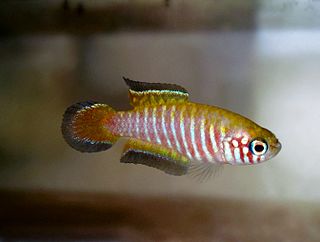
Pseudochorthippus parallelus, the meadow grasshopper, is a common species of grasshopper in the tribe Gomphocerini. It is found in non-arid grasslands throughout the well vegetated areas of Europe and some adjoining areas of Asia. It is a well-studied organism in the discipline of evolutionary biology and was an early and important model system for the study of European phylogeography.
Anomiopus is a genus of scarab beetles in the family Scarabaeidae. There are more than 60 described species in Anomiopus, found in Central and South America.
A not evaluated (NE) species is one which has been categorized under the IUCN Red List of threatened species as not yet having been assessed by the International Union for Conservation of Nature. A species which is uncategorized and cannot be found in the IUCN repository is also considered 'not evaluated'.

Dorcus parallelus, more commonly known as the antelope stag beetle, is a species from the Lucanidae family. Extensive research has not been done on this species. D. parallelus has been seen to be endemic to North America. Features of this species include its impressive size and distinctive antler-like mandibles useful during mating. These beetles are often compared to Dorcus parallelipipedus, the sister species mainly concentrated in Europe.
Anomiopus ataenioides is a species of true dung beetle that is endemic to northern Argentina, and is known from Salta, Jujuy, Tucumán and Corrientes provinces. It is believed to share ant colony nests (myrmecophile).
Anomiopus birai is a species of true dung beetle that is known from Caaguazú and Concepción departments of Paraguay, and Mato Grosso do Sul and Mato Grosso states of Brazil. It is found in cerrado savanna at low altitudes, and is a myrmecophile.
Anomiopus bonariensis is a species of true dung beetle that can be found in Argentina, Brazil and Uruguay. It is a myrmecophile, and has been recorded living in nests of Acromyrmex lundii.
Anomiopus idei is a species of true dung beetle that is endemic to Perú, and is only known from its type locality in Loreto Region.
Anomiopus lacordairei is a species of true dung beetle that is endemic to French Guiana, and is only known from Cayenne. It has been recorded from lowland forests, and it may be a myrmecophile.
Anomiopus laetus is a species of true dung beetle that is endemic to Brazil, and is known from Amazonas, Pará and Acre states. It may be a myrmecophile.
Anomiopus nigrocoeruleus is a species of true dung beetle that can be found in Argentina, Brazil and Paraguay. It can be found in cerrado and chaco biomes. It may be a myrmecophile.
Anomiopus pictus is a species of true dung beetle that can be found in Brazil and Perú. It may be a myrmecophile.
Anomiopus smaragdinus is a species of true dung beetle that can be found in Brazil, French Guiana, Venezuela and Bolivia. It may be a myrmecophile.
Anomiopus soledari is a species of true dung beetle that is endemic to Brazil, and can be found in the Federal District and Goiás State. It can be found in the cerrado biome, and may be a myrmecophile.
Anomiopus virescens is a species of true dung beetle that can be found in Bolivia, Brazil and Paraguay. It can be found in the cerrado biome and surrounding areas, and is likely to be nocturnal and a myrmecophile.

Centropomus parallelus is a species of fish in the family Centropomidae, the snooks and robalos. It is known by several common names, including fat snook, smallscale fat snook, little snook, and chucumite. It is native to the western Atlantic Ocean and Gulf of Mexico, its distribution extending from southern Florida in the United States to southern Brazil near Florianópolis.
Anomiopus gracilis is a species of true dung beetle that can be found in Brazil and Venezuela.
Anomiopus howdeni is a species of true dung beetle that can be found in Brazil and French Guiana.

Halictus parallelus is a species of sweat bee in the family Halictidae.

Simpsonichthys parallelus is a species of killifish in the family Rivulidae. It is found in the Paraná River basin of Brazil.





